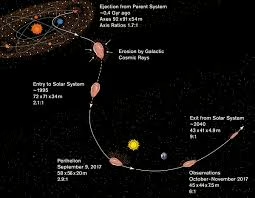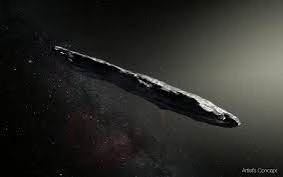
Introduction to Oumuamua
In October 2017, astronomers discovered an object passing through our solar system at an astonishing speed—too fast to be bound by the Sun’s gravity. Initially categorized as an asteroid, it was soon identified as something far more extraordinary: an interstellar object from outside our solar system. The discovery of this object, officially named Oumuamua, marked the first time an object from another star system had been observed in our own solar system. But what was Oumuamua? A natural space rock? A comet without a tail? Or something else entirely?
The name Oumuamua comes from the Hawaiian word meaning “scout” or “messenger,” fitting for an object that seemed to arrive without warning, shrouded in mystery. At the time of its discovery, astronomers were baffled by its unusual characteristics, particularly its speed, trajectory, and lack of a visible tail—something almost all comets display as they approach the Sun. These strange features prompted a flurry of excitement and controversy, with many theorizing about the object’s origin, its true nature, and whether it might be a message from an alien civilization.

*2. Characteristics of Oumuamua
Shape and Size
One of the most peculiar aspects of Oumuamua was its shape. Early observations suggested that it was highly elongated—cigar-shaped or even pancake-like—unlike any known object in our solar system. Its size was estimated to be roughly 100 to 800 meters in length, though precise measurements were difficult due to the object’s speed and distance. The object was rotating on its axis every 7.3 hours, a feature that was inferred from its periodic brightness changes as it reflected sunlight. However, what intrigued scientists most was how its shape could have affected its trajectory and behavior.
Trajectory and Speed
Oumuamua’s trajectory was a key point of interest. Unlike asteroids or comets that are bound to the Sun, Oumuamua was on a hyperbolic orbit, meaning it was moving fast enough to escape the Sun’s gravitational pull. It passed through the solar system at an incredible speed of 315,000 kilometers per hour (196,000 miles per hour). The speed of Oumuamua indicated that it was not from the solar system and had been traveling through interstellar space for millions of years. This high velocity raised significant questions: Why had it come so close to the solar system, and what could have caused its peculiar motion?
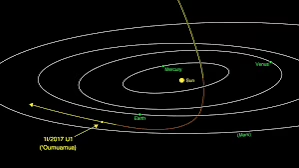
Absence of a Tail
Comets are typically accompanied by a glowing tail of gas and dust, a result of the Sun’s heat causing the comet’s volatile materials to evaporate. However, Oumuamua did not exhibit any visible tail, even as it passed close to the Sun. This lack of a tail initially led scientists to question whether Oumuamua was truly a comet. Despite some initial claims that it was a dry comet, the absence of a tail has remained one of the most puzzling aspects of its discovery.
Rotation and Outgassing
Oumuamua displayed rapid fluctuations in its brightness, which indicated that it was tumbling through space rather than rotating steadily like most objects in the solar system. Some scientists speculated that the object’s uneven shape could cause the light reflected off its surface to change in intensity as it rotated. Others believed that Oumuamua might have been losing material from its surface (outgassing), much like a comet, but without a visible tail. However, no outgassing was detected, adding to the mystery.
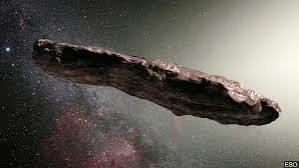
*3. Theories about Oumuamua
Natural Explanations
Comet Without a Tail
Some scientists initially theorized that Oumuamua could be a comet that simply lacked a visible tail. One possibility is that it was a dry comet, without the necessary volatile materials to produce a visible outgassing effect. Comets generally release gas and dust as they approach the Sun, but Oumuamua could have been a unique case. Still, the absence of even minimal outgassing made this theory less likely.
Asteroid with Unusual Composition
Others suggested that Oumuamua was an asteroid, perhaps composed of metal or rock. In this case, its unusual shape could be the result of a collision or the remnant of a larger celestial body that had been shattered. Oumuamua’s high speed and trajectory could also have been explained by its being ejected from a distant star system, possibly after a close encounter with a larger planet or celestial body.
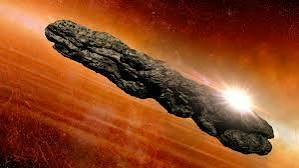
Solar Sail Hypothesis
One of the more intriguing theories proposed that Oumuamua could be a solar sail, a thin, lightweight object propelled by radiation pressure. Solar sails are hypothetical devices designed to travel through space by harnessing the pressure exerted by light from stars. If Oumuamua were a thin, flat object, it might explain its acceleration through space without the need for traditional propulsion. However, the solar sail hypothesis was controversial, and many astronomers were skeptical of its plausibility, given that no known solar sail exists and Oumuamua did not appear to fit the specific characteristics of one.
Fragment from a Larger Body
A more conservative explanation is that Oumuamua could be a fragment of a much larger body, broken apart by some cosmic event, such as a supernova or a collision. This would account for its shape, trajectory, and lack of outgassing, though it remains speculative.
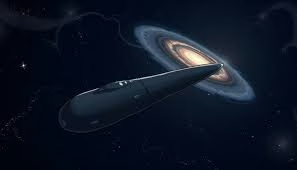
The Alien Hypothesis
Loeb’s Proposal
Perhaps the most controversial and widely discussed theory came from Harvard astronomer Avi Loeb, who suggested that Oumuamua could be an artificial object sent by an alien civilization. Loeb argued that the object’s speed, shape, and acceleration as it passed through the solar system were too peculiar to be explained by natural forces alone. According to Loeb, Oumuamua might be a probe or spacecraft designed to explore interstellar space. The object’s unusual acceleration—caused by radiation pressure—was particularly compelling, leading Loeb to propose that Oumuamua was either an intentional or accidental visitor from another star system.
Criticism and Backlash
The alien hypothesis generated significant backlash from the scientific community. Many astronomers rejected Loeb’s theory as far-fetched and unsupported by evidence. They pointed out that natural explanations, such as the outgassing of gas from a comet or the breakup of a larger celestial body, were far more plausible. Despite the criticism, Loeb’s theory gained considerable public attention, and it sparked ongoing debates about the possibility of extraterrestrial life.
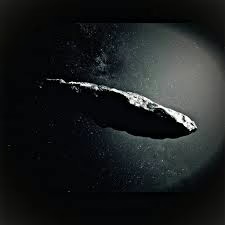
Other Fantastical Theories
Interstellar Probe or Artifact
In addition to Loeb’s hypothesis, some have speculated that Oumuamua could be an interstellar probe, intentionally or unintentionally sent by an advanced alien civilization. Whether it was a piece of technology designed for exploration or some form of cosmic artifact remains an open question, though the theory is highly speculative.
A Cosmic Message
A few more extravagant theories have proposed that Oumuamua could be a type of interstellar communication—an artifact intended to send a message from an alien civilization. This theory taps into the growing interest in the search for extraterrestrial intelligence (SETI) and the possibility that other civilizations may be attempting to communicate with humanity.
*4. Oumuamua’s Legacy in Astronomy
Impact on Astronomy
The discovery of Oumuamua has had a profound impact on astronomy, sparking widespread interest in interstellar objects and the possibility of intelligent life beyond our solar system. It also raised new questions about the nature of interstellar travel and the possibility of detecting other objects from distant star systems.
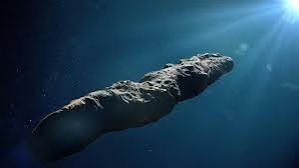
The Breakthrough Listen Project
The object’s unusual nature led to renewed interest in projects like the Breakthrough Listen initiative, which aims to detect signals from extraterrestrial civilizations. Oumuamua was a catalyst for discussions on how astronomers could search for more interstellar objects and how to interpret signals from objects passing through our solar system.
Search for Other Interstellar Objects
Following Oumuamua’s discovery, astronomers began searching for other interstellar objects. In 2019, a second interstellar object, 2I/Borisov, was detected, providing additional data and fueling further research into interstellar visitors. The discovery of Oumuamua proved that such objects could exist and prompted efforts to build better telescopes and detection systems.

5. Conclusion
As of today, Oumuamua remains an unresolved mystery. The object’s strange characteristics defy easy classification, and while natural explanations such as a comet or asteroid fragment seem the most likely, the possibility of an artificial origin continues to intrigue scientists and the public alike. Whether it is a simple cosmic rock or the remnants of an alien civilization’s probe, Oumuamua has sparked a new era of interstellar exploration.
The enigma of Oumuamua has reminded us that the universe is vast, filled with mysteries that challenge our understanding of the cosmos. Its discovery has opened up new frontiers in space research and will continue to inspire questions about the nature of life, technology, and the possibility of contact with extraterrestrial civilizations.
As astronomers continue to study objects from outside our solar system, we can only hope that Oumuamua is the first of many interstellar visitors to spark our curiosity and deepen our understanding of the universe around us.
